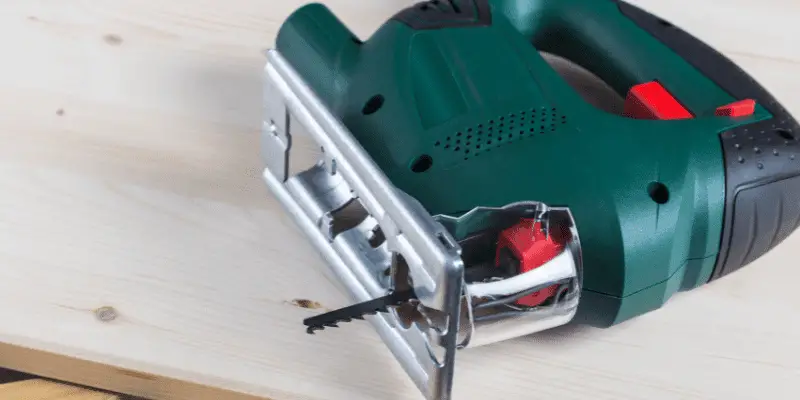Band saws are best for straight cuts in thick materials, while jigsaws are great for curved and intricate cuts in various materials. Both tools have their own unique applications, benefits, and limitations, making them suitable for different types of woodworking and cutting tasks.
When working with wood, metal, or plastic, it’s essential to choose the right cutting tool for the job. Band saws are perfect for making straight cuts in large, thick materials, providing precision and stability. On the other hand, jigsaws are versatile and ideal for making curved or irregular cuts, offering greater maneuverability and flexibility.
Understanding the differences between band saws and jigsaws can help you select the right tool for your specific cutting needs. We will compare both tools in terms of features, applications, and functionality to help you make an informed decision for your woodworking projects.
Understanding Band Saw And Jigsaw
When it comes to cutting through wood and metal, two power tools that are commonly used are the band saw and the jigsaw. Both tools have unique characteristics and are suitable for different applications. Understanding the differences between these two tools can help you make an informed decision when it comes to choosing the right tool for your woodworking or metalworking projects.
Differentiating Functionality
The band saw and jigsaw are both versatile cutting tools, but they differ significantly in terms of functionality. Let’s take a closer look at how each tool operates:
- Band saw: A band saw is a stationary power tool typically used for cutting large and thick materials. It features a continuous looped blade that moves in a vertical motion, allowing for precise and straight cuts. Band saws are ideal for resawing and cutting curves and irregular shapes.
- Jigsaw: On the other hand, a jigsaw is a handheld power tool that operates with a reciprocating blade. It is suitable for cutting curves, notches, and intricate shapes on thinner materials. Jigsaws offer more maneuverability and versatility for intricate cutting tasks.
Cutting Capabilities And Limitations
| Aspect | Band Saw | Jigsaw |
|---|---|---|
| Straight cuts | Highly precise for straight cuts, especially on thick materials | Suitable for straight cuts on thinner materials, but less precise compared to a band saw |
| Curved cuts | Can cut smooth and intricate curves with ease | Well-suited for cutting curves and irregular shapes |
| Material thickness | Designed for cutting thick materials with ease | Best for cutting thinner materials and intricate designs |
| Maneuverability | Limited maneuverability as a stationary tool | Offers greater maneuverability due to its handheld nature |
Understanding the cutting capabilities and limitations of both the band saw and jigsaw can help you determine which tool is best suited for your specific cutting needs.
Power And Precision Comparison
When it comes to choosing the right power tool for woodworking and cutting tasks, considering the power and precision is crucial. Both the band saw and jigsaw are popular choices among woodworkers, each offering distinctive power and precision features. Let’s compare the power and precision of these two tools to help you make an informed decision based on your specific needs.
Band Saw Power And Accuracy
The band saw is known for its robust power and remarkable accuracy. Equipped with a powerful motor, band saws are capable of handling heavy-duty cutting tasks, such as cutting thick and large pieces of wood with ease. Additionally, the continuous blade movement in a band saw allows for precise and smooth cuts, making it an ideal tool for intricate curved or straight cuts.
Jigsaw Power And Precision
When it comes to power and precision, the jigsaw excels in offering versatility and maneuverability. Featuring a motor that provides ample power for cutting various materials, the jigsaw is also renowned for its maneuverability, allowing users to make intricate cuts and navigate tight spaces with precision. Moreover, the ability to adjust the speed and orbital action of the blade further enhances the precision and control when making cuts.
Material Suitability
When choosing between a band saw and a jigsaw, it’s essential to consider the suitability of the materials you’ll be working with. Each tool has its strengths and ideal applications, and understanding which materials are best suited for each can help you achieve the best results.
Ideal Materials For Band Saw Cutting
Band saws are ideal for cutting a wide range of materials, including:
- Wood
- Metal
- Plastic
- Thick or large pieces of material
Best Materials For Jigsaw Cutting
When it comes to material suitability, jigsaws are well-suited for cutting:
- Wood
- Thin metal sheets
- Laminate
- PVC
Versatility And Maneuverability
When it comes to woodworking and other DIY projects, choosing the right power tool can make all the difference. In the debate between band saws and jigsaws, one essential factor to consider is their versatility and maneuverability. Both tools offer unique benefits, and understanding their capabilities in relation to these aspects is crucial for making an informed decision.
Band Saw Maneuverability And Versatility
Band saws are renowned for their ability to make precise and intricate cuts, thanks to their continuous loop blade design. Despite their larger size, modern band saws are designed with enhanced maneuverability, making them suitable for various cutting tasks. Their vertical orientation allows for intricate curves and detailed cuts, making them versatile for a wide range of woodworking projects. Additionally, with the availability of different blade types, widths, and tooth configurations, band saws can handle various materials with ease, from wood to metal.
Jigsaw Maneuverability And Versatility
On the other hand, jigsaws are hailed for their exceptional maneuverability, especially in tight or curved spaces. Their compact size and maneuverability make them ideal for cutting shapes, curves, and patterns with ease. With the ability to make bevel cuts and plunge cuts, jigsaws are versatile tools suitable for intricate woodworking and home improvement projects. Furthermore, the availability of different blade types for cutting different materials enhances their versatility, making them a go-to choice for smaller-scale projects and fine detailing.

Application And Decision
When it comes to woodworking or metal cutting, choosing the right power tool can be crucial. Band saws and jigsaws are both versatile machines, but they serve different purposes. Knowing which one to use for a particular project is essential for achieving the best results.
Selecting The Ideal Tool For Specific Projects
Each tool has its own unique applications, and understanding these will help in making the right choice for any given project.
Factors Influencing The Choice Between Band Saw And Jigsaw
In order to select the ideal tool for each project, it’s important to consider the following factors:
- Type of Cut: Band saws are ideal for straight and curved cuts in thicker materials, while jigsaws excel at making intricate curved cuts in thinner materials.
- Material: Consider the type and thickness of the material being worked on. Band saws are better suited for thicker materials, while jigsaws are more appropriate for thinner materials.
- Precision: If precision is essential, a jigsaw with its maneuverability and smaller blade might be the better option.
- Workspace: Band saws require more space and typically have larger cutting capacities, whereas jigsaws are more maneuverable in tight spaces.
- Cost: Band saws are generally more expensive than jigsaws, so budget considerations may come into play.
- Versatility: While both machines are versatile, a band saw may offer more flexibility in terms of cutting capabilities due to its larger blade and throat size.
Frequently Asked Questions On Band Saw Vs Jigsaw
What Are The Key Differences Between A Band Saw And A Jigsaw?
A band saw is best for straight and curved cuts on large pieces, while a jigsaw is versatile for intricate cuts and plunge cuts, suitable for smaller workpieces.
Which Projects Are Better Suited For A Band Saw Over A Jigsaw?
Band saws are ideal for cutting thick, hard materials and creating smooth, uniform cuts, making them suitable for woodworking and metalworking projects.
Can A Jigsaw Be Used For The Same Tasks As A Band Saw?
While a jigsaw can handle curved cuts and intricate designs, it may struggle with thicker materials and straight-line cuts that a band saw excels at.
Conclusion
Whether you choose a band saw or a jigsaw, consider your specific cutting needs. Both tools have unique capabilities and excel in different tasks. Having the right tool for the job ensures precise and efficient cutting. It all boils down to what works best for your project’s requirements and your cutting preferences.


